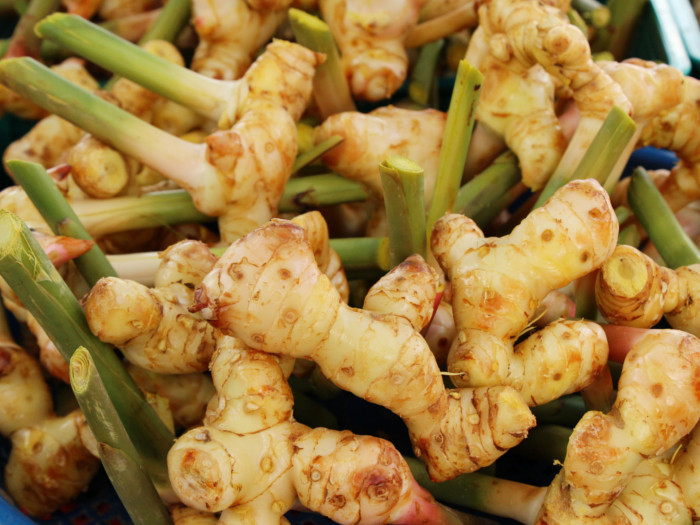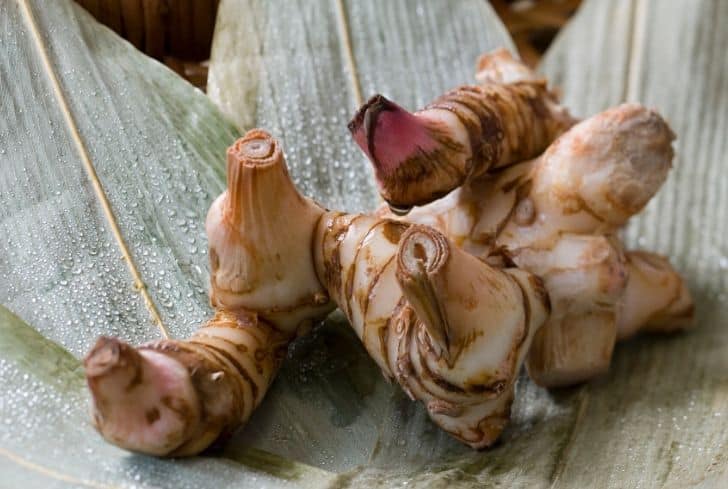Hey there, my fellow food enthusiasts! Today, I’ve got a super interesting ingredient to share with you all - galangal! Now, I know what you’re thinking, “What on earth is galangal?” Well, my dear friends, galangal is a root that belongs to the ginger family. It has a distinct aroma and flavor that adds a delightful kick to any dish. So, buckle up and let’s dive into the fabulous world of galangal!
Galangal as an Ingredient (and where to find)
First things first, let me show you how this magnificent ingredient looks like:
 Now, if you’re wondering where to find galangal, fret not! You can typically find it in Asian grocery stores or specialized spice stores. Alternatively, you can also try growing your own galangal in your garden. It’s a rewarding experience, and you’ll have fresh galangal at your fingertips whenever you need it!
Now, if you’re wondering where to find galangal, fret not! You can typically find it in Asian grocery stores or specialized spice stores. Alternatively, you can also try growing your own galangal in your garden. It’s a rewarding experience, and you’ll have fresh galangal at your fingertips whenever you need it!
What Is Galangal Used For: How To Grow Galangal In The Garden
Oh, the possibilities with galangal are endless! This amazing root is frequently used in Asian cuisines, particularly Thai, Indonesian, and Malaysian dishes. Its pungent and citrusy flavor adds a unique twist to curries, soups, stir-fries, and marinades. Trust me, once you start using galangal in your cooking, there’s no going back!
 If you’re feeling a bit adventurous, why not try growing galangal in your garden? It’s relatively easy to cultivate, and you’ll have a fresh and sustainable supply right at home. Galangal thrives in warm and humid climates, so make sure to provide it with the right conditions. Before you know it, you’ll be harvesting your very own galangal!
If you’re feeling a bit adventurous, why not try growing galangal in your garden? It’s relatively easy to cultivate, and you’ll have a fresh and sustainable supply right at home. Galangal thrives in warm and humid climates, so make sure to provide it with the right conditions. Before you know it, you’ll be harvesting your very own galangal!
Herbal Medicine Archives - Page 2 of 9 - Best-Home-Remedies.com
Did you know that galangal also has some remarkable medicinal properties? Yep, that’s right! This wonderful root has been used for centuries in traditional medicine to treat various ailments. It’s known for its anti-inflammatory, antibacterial, and antioxidant properties. Galangal can aid digestion, alleviate nausea, and even boost your immune system. It’s like a superhero in root form!
![]() While galangal is primarily used in culinary applications, don’t underestimate its potential in the realm of natural remedies. Just make sure to consult with a healthcare professional before using it for any medicinal purposes!
While galangal is primarily used in culinary applications, don’t underestimate its potential in the realm of natural remedies. Just make sure to consult with a healthcare professional before using it for any medicinal purposes!
BBC - Food - Galangal recipes
No food journey would be complete without some tantalizing recipes. So here are a few delectable dishes that showcase the magic of galangal:
 1. Thai Red Curry with Galangal and Bamboo Shoots: This aromatic curry will transport you straight to the bustling streets of Thailand. The combination of galangal, lemongrass, and coconut milk creates an explosion of flavors that will leave you craving for more.
1. Thai Red Curry with Galangal and Bamboo Shoots: This aromatic curry will transport you straight to the bustling streets of Thailand. The combination of galangal, lemongrass, and coconut milk creates an explosion of flavors that will leave you craving for more.
2. Indonesian Beef Rendang: This mouthwatering beef dish is slow-cooked with galangal, along with a heavenly blend of spices and coconut milk. The result is tender, flavorful meat that will melt in your mouth.
3. Malaysian Tom Yum Soup: This tangy and spicy soup is a Malaysian classic. The galangal works its magic alongside lemongrass, kaffir lime leaves, and shrimp to create a symphony of flavors that will warm your soul.
6 Surprising Benefits of Galangal | Organic Facts
Aside from its culinary and medicinal uses, galangal offers a range of surprising health benefits:
 1. Anti-inflammatory Properties: Galangal contains potent compounds that can help reduce inflammation in the body, making it beneficial for conditions like arthritis.
1. Anti-inflammatory Properties: Galangal contains potent compounds that can help reduce inflammation in the body, making it beneficial for conditions like arthritis.
2. Improved Digestion: This fantastic root can aid digestion, relieve indigestion, and soothe an upset stomach. Say goodbye to those post-meal discomforts!
3. Boosted Immunity: Galangal is packed with antioxidants that help strengthen your immune system and ward off pesky illnesses.
4. Enhanced Brain Function: Some research suggests that galangal may have neuroprotective properties and could potentially improve cognitive function.
5. Reduced Nausea: If you’re feeling queasy, galangal could be your savior. Its natural compounds can help alleviate nausea and calm an uneasy stomach.
6. Healthy Hair and Skin: Galangal’s antioxidant and antimicrobial properties make it a fantastic ingredient for promoting healthy hair and skin. It can help fight signs of aging and keep your locks luscious and your skin radiant.
13 Amazing Health Benefits of Galangal - Conserve Energy Future
But wait, there’s more! Here are a few additional health benefits that galangal brings to the table:
 1. Relief from Menstrual Cramps: Galangal has been traditionally used to alleviate the pain and discomfort associated with menstrual cramps.
1. Relief from Menstrual Cramps: Galangal has been traditionally used to alleviate the pain and discomfort associated with menstrual cramps.
2. Diabetes Management: Research suggests that galangal may help regulate blood sugar levels, making it potentially beneficial for individuals with diabetes.
3. Improved Heart Health: Galangal contains compounds that can help lower cholesterol levels and lower the risk of cardiovascular diseases.
4. Anticancer Potential: Some studies have shown that galangal may possess anticarcinogenic properties, providing potential benefits in cancer prevention and treatment.
5. Relief from Respiratory Issues: Galangal’s natural compounds can help relieve respiratory issues like cough, cold, and congestion.
6. Pain Relief: Galangal has traditionally been used to alleviate various types of pain, including headaches and muscle aches.
8 Galangal Substitutes - 8 Galangal Substitutes That You Need To Understand
So, you’re all set to whip up a delicious dish that calls for galangal, but you can’t get your hands on it? Fret not, my friends! Here are a few galangal substitutes that you need to understand:
 1. Ginger: This is the closest and most accessible substitute for galangal. While the flavors may differ slightly, ginger can still bring that lovely zing to your dish.
1. Ginger: This is the closest and most accessible substitute for galangal. While the flavors may differ slightly, ginger can still bring that lovely zing to your dish.
2. Thai Ginger or Finger Root: This ginger variant is a member of the galangal family and offers a similar flavor profile.
3. Black Cardamom: If you’re looking for that smoky and earthy flavor, black cardamom can be an excellent substitute for galangal.
4. Turmeric: While turmeric won’t add the same citrusy taste, it can provide a vibrant color and a mild earthy flavor.
5. Coriander Root: Coriander root shares some aromatic compounds with galangal, making it a suitable substitute in certain dishes.
6. Japanese Pickled Ginger: This pink-colored ginger variation can work as a substitute for galangal in a pinch.
7. Lemon Zest: For a touch of citrusy goodness, lemon zest can be used as a substitute, although it won’t provide the same depth of flavor as galangal.
8. Kaffir Lime Leaves: If you’re after that delicate and citrusy aroma, kaffir lime leaves can be a suitable substitute for galangal.
What Is Galangal And How Do I Use It? - Food Republic
There you have it, folks - a comprehensive guide to galangal and all its wonders! Now, it’s time to put your galangal knowledge to use and explore the world of flavor it has to offer. Feel free to experiment with this incredible ingredient and let your taste buds go on an exciting adventure. Happy cooking!
 Note: The information provided in this article is for educational purposes only and should not be considered as medical advice. Please consult with a healthcare professional or nutritionist before making any changes to your diet or lifestyle.
Note: The information provided in this article is for educational purposes only and should not be considered as medical advice. Please consult with a healthcare professional or nutritionist before making any changes to your diet or lifestyle.
Greater Galangal - How to Choose & Use It
Sources:
1. https://cookingwithlane.com/wp-content/uploads/2020/02/galangal-002.jpg
2. https://www.gardeningknowhow.com/wp-content/uploads/2016/12/galangal-.jpg
4. http://ichef.bbci.co.uk/food/ic/food_16x9_608/foods/g/galangal_16x9.jpg
5. https://imagesvc.meredithcorp.io/v3/mm/image?q=85&c=sc&poi=face&w=20…
6. https://www.organicfacts.net/wp-content/uploads/galangal.jpg
7. https://www.conserve-energy-future.com/wp-content/uploads/2020/04/Galangal.jpg
8. https://www.greedygourmet.com/wp-content/uploads/2020/06/Galangal-720x1058.jpg
9. https://www.foodrepublic.com/wp-content/uploads/2014/01/galangal.jpg
10. https://www.diversivore.com/wp-content/uploads/2019/02/Greater-Galangal-square.jpg